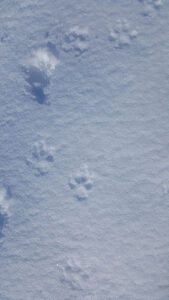BY HARRY WEEKES
 This spring provided one of those wonderful and intermittent opportunities we get when a big winter has a little bit of rain, a lot of sunshine, and a return of freezing temperatures—crust cruising. These conditions create what my siblings and I classified as “hard ground” when we were growing up, and the phrase to which we come back to even though all of us are in our 50s.
This spring provided one of those wonderful and intermittent opportunities we get when a big winter has a little bit of rain, a lot of sunshine, and a return of freezing temperatures—crust cruising. These conditions create what my siblings and I classified as “hard ground” when we were growing up, and the phrase to which we come back to even though all of us are in our 50s.
This was an epic hard-ground year and reminded me of one of my favorite aspects of this condition—you can literally go anywhere, with the major trail impediment being slope (as I found when I slipped, then went shooting down the ridge behind my in-laws’ house).
Throughout late March and early April, I got to amble all over the terrain behind and around my house, walking straight up faces I had previously only zigzagged across, making the overland trek from my house to school along “the back way” through Deadman’s Gulch, and being able to find and follow all sorts of tracks as they, too, seemed to meander in interesting ways.
One set of tracks was particularly intriguing, emerging one day and cutting a line directly to a lump in the snow. This path grew more and more defined, a sign that someone was moving back and forth to what was sure to be a den of some kind. Throughout my steady surveillance, I also noticed something else—just how much snow was disappearing each day.
The bright blue days were piercing. And the snow was literally evaporating—going straight from solid to gas in the process of sublimation. Then it dawned on me that what I was seeing was not new tracks at all, but the return of old ones.
Yes, this demonstrates the extent of my tracking skills (or lack thereof). More interesting to me, though, was this gradual peeling back of winter. These tracks happened… when? As soon as I started noticing this, other tracks followed—a new set emerging already looking old and exposed to the sun, because they happened sometime in January? And those crisscrosses? While they looked to be totally different, they now seemed to highlight the same beast’s pattern from different times—a lighter, thinner set having been covered soon after they were made, and the deeper, broader set having been covered after some exposure to the sun.
I got to spend several weeks mulling over this frozen record, peeled back one or two inches at a time—this winter chronology moving in reverse. I am sure that people exploring ice cores in Greenland and Antarctica get this same sense of awe—connecting frozen gas signatures to life on the planet tens and hundreds of thousands of years ago, and even connecting those gases to global events—a century of melting, a dramatic series of volcanic explosions, or the comings and goings of great legions of flora and fauna.
My world is a whole lot simpler. “There went a fox. Maybe in February?” And, “This seems to be where the coyotes walk. Or maybe it was a wayward badger?”
A palimpsest is something you write on that you can erase and write on again. This process invariably leaves ghosts of the past, like we see on a poorly erased chalkboard.
This spring literally uncovered what each storm erased, walking me back through the year, walking me back through the frozen archive until, like so many seasonal things, it all literally vanished.
Harry Weekes is the Founder and Head of School at The Sage School in Hailey. This is his 50th year in the Wood River Valley, where he lives with Hilary and one of their three baby adults- Simon. The other members of the flock, Georgia and Penelope, are currently fledging at Davidson College in North Carolina and Middlebury College in Vermont.
